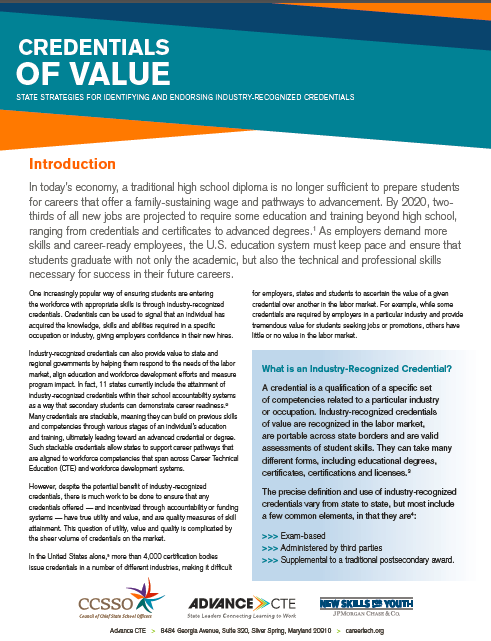The Strengthening Career and Technical Education for the 21st Century Act (Perkins V) puts an increased emphasis on the use of labor market information (LMI). Perkins V includes an amendment to the Wagner-Peyser (Title III of the Workforce Innovation and Opportunity Act) to ensure that labor market information produced under Wagner-Peyser can be readily accessed and used by the states and in turn, local recipients. In addition, the law requires an analysis of how CTE programs are meeting labor market needs as part of the comprehensive local needs assessment that local recipients of Perkins funds must complete. Labor market information is also one component of how states may determine which credentials should count as recognized postsecondary credentials (a term that is defined in Perkins V and used in the accountability system). How can states effectively leverage labor market information when approaching implementation of Perkins V? Check out the resources below to learn more.
GUIDE: Putting Labor Market Information in the Right Hands: This guide is designed to help states think through the process of disseminating LMI more strategically. The guide highlights different states approached and their dissemination of LMI to employers, districts and learners, and poses guiding questions for states to consider for each of those audiences.
 BRIEF: Credentials of Value: State Strategies for Identifying and Endorsing Industry-Recognized Credentials: This paper highlights promising practices from states that have made considerable progress developing a system for students and employers to navigate the tangled universe of credentials. The brief further describes how each state tackles the challenge in a different way, building a system that suits their local economy and context, and highlights a few common strategies.
BRIEF: Credentials of Value: State Strategies for Identifying and Endorsing Industry-Recognized Credentials: This paper highlights promising practices from states that have made considerable progress developing a system for students and employers to navigate the tangled universe of credentials. The brief further describes how each state tackles the challenge in a different way, building a system that suits their local economy and context, and highlights a few common strategies.
POLICY PROFILES
- Kansas: Excel in CTE: Excel in CTE was launched in 2012 to help students transition to postsecondary education and training by increasing industry-recognized credential attainment and dual enrollment. The program has grown substantially since then, serving more than 10,000 students a year.
- Florida: Career and Professional Education Act (CAPE): Florida’s CAPE Act, initially passed in 2007, models how states can engage with industry and define quality industry certification standards for secondary and postsecondary students.

